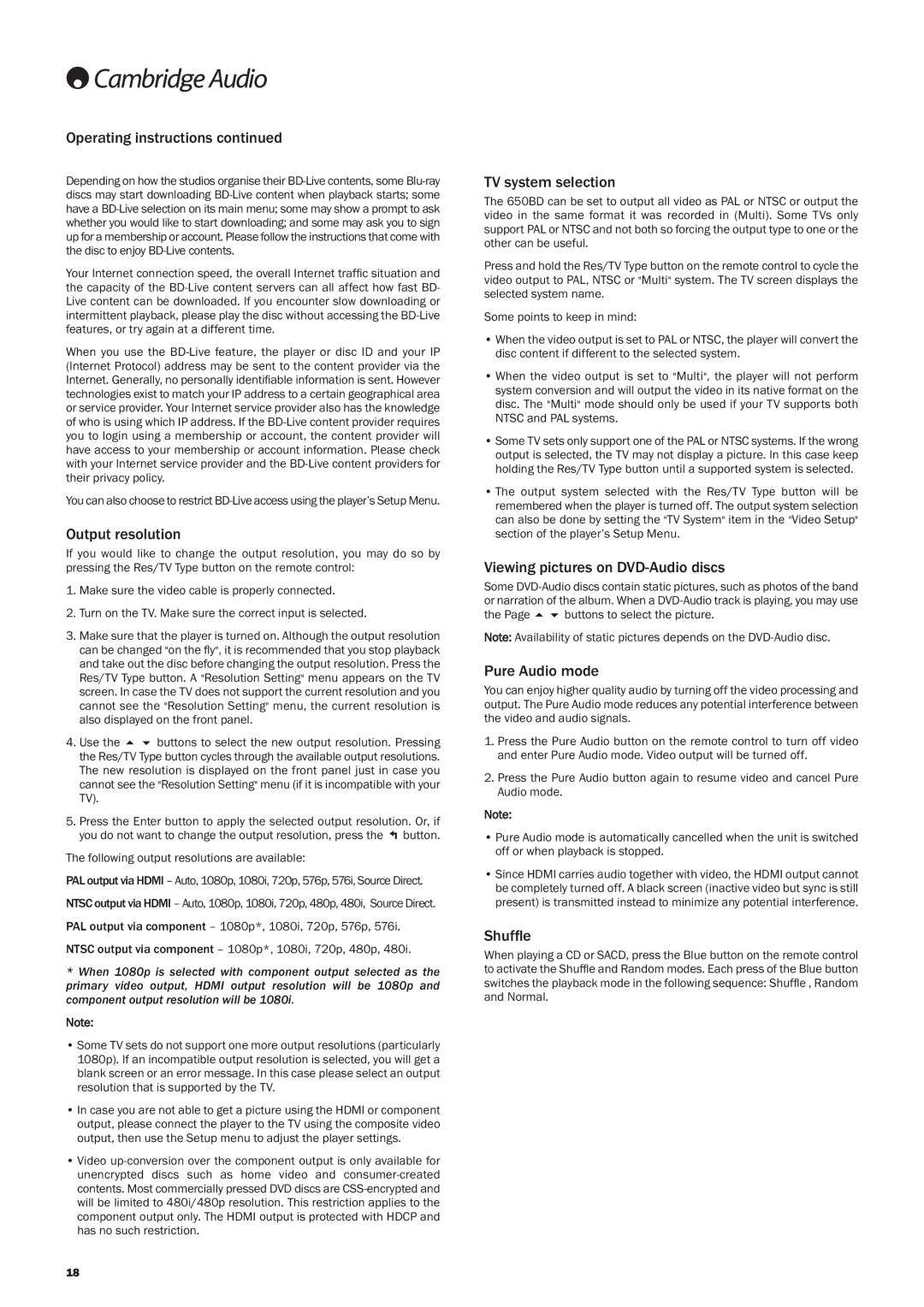Operating instructions continued
Depending on how the studios organise their
Your Internet connection speed, the overall Internet traffic situation and the capacity of the
When you use the
You can also choose to restrict
Output resolution
If you would like to change the output resolution, you may do so by pressing the Res/TV Type button on the remote control:
1.Make sure the video cable is properly connected.
2.Turn on the TV. Make sure the correct input is selected.
3.Make sure that the player is turned on. Although the output resolution can be changed "on the fly", it is recommended that you stop playback and take out the disc before changing the output resolution. Press the Res/TV Type button. A "Resolution Setting" menu appears on the TV screen. In case the TV does not support the current resolution and you cannot see the "Resolution Setting" menu, the current resolution is also displayed on the front panel.
4. Use the buttons to select the new output resolution. Pressing the Res/TV Type button cycles through the available output resolutions. The new resolution is displayed on the front panel just in case you cannot see the "Resolution Setting" menu (if it is incompatible with your TV).
5.Press the Enter button to apply the selected output resolution. Or, if you do not want to change the output resolution, press the ![]()
![]() button.
button.
The following output resolutions are available:
PAL output via HDMI – Auto, 1080p, 1080i, 720p, 576p, 576i, Source Direct.
NTSC output via HDMI – Auto, 1080p, 1080i, 720p, 480p, 480i, Source Direct.
PAL output via component – 1080p*, 1080i, 720p, 576p, 576i.
NTSC output via component – 1080p*, 1080i, 720p, 480p, 480i.
*When 1080p is selected with component output selected as the primary video output, HDMI output resolution will be 1080p and component output resolution will be 1080i.
Note:
•Some TV sets do not support one more output resolutions (particularly 1080p). If an incompatible output resolution is selected, you will get a blank screen or an error message. In this case please select an output resolution that is supported by the TV.
•In case you are not able to get a picture using the HDMI or component output, please connect the player to the TV using the composite video output, then use the Setup menu to adjust the player settings.
•Video
TV system selection
The 650BD can be set to output all video as PAL or NTSC or output the video in the same format it was recorded in (Multi). Some TVs only support PAL or NTSC and not both so forcing the output type to one or the other can be useful.
Press and hold the Res/TV Type button on the remote control to cycle the video output to PAL, NTSC or "Multi" system. The TV screen displays the selected system name.
Some points to keep in mind:
•When the video output is set to PAL or NTSC, the player will convert the disc content if different to the selected system.
•When the video output is set to "Multi", the player will not perform system conversion and will output the video in its native format on the disc. The "Multi" mode should only be used if your TV supports both NTSC and PAL systems.
•Some TV sets only support one of the PAL or NTSC systems. If the wrong output is selected, the TV may not display a picture. In this case keep holding the Res/TV Type button until a supported system is selected.
•The output system selected with the Res/TV Type button will be remembered when the player is turned off. The output system selection can also be done by setting the "TV System" item in the "Video Setup" section of the player’s Setup Menu.
Viewing pictures on DVD-Audio discs
Some
the Page | buttons to select the picture. |
Note: Availability of static pictures depends on the
Pure Audio mode
You can enjoy higher quality audio by turning off the video processing and output. The Pure Audio mode reduces any potential interference between the video and audio signals.
1.Press the Pure Audio button on the remote control to turn off video and enter Pure Audio mode. Video output will be turned off.
2.Press the Pure Audio button again to resume video and cancel Pure Audio mode.
Note:
•Pure Audio mode is automatically cancelled when the unit is switched off or when playback is stopped.
•Since HDMI carries audio together with video, the HDMI output cannot be completely turned off. A black screen (inactive video but sync is still present) is transmitted instead to minimize any potential interference.
Shuffle
When playing a CD or SACD, press the Blue button on the remote control to activate the Shuffle and Random modes. Each press of the Blue button switches the playback mode in the following sequence: Shuffle , Random and Normal.
18
